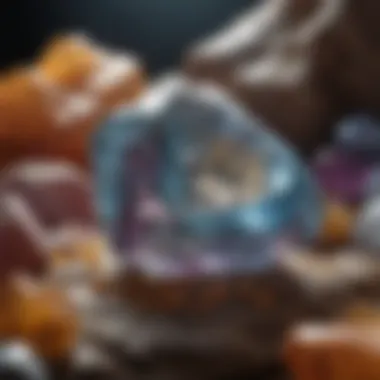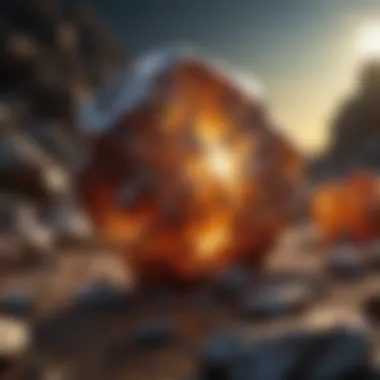Unveiling the Enigmatic Universe of Rocks and Minerals: A Comprehensive Exploration


Rock and Fossil Identification
When engaging in the mesmerizing world of rocks and minerals, an essential aspect for enthusiasts is mastering the identification of various types of rocks and fossils. Understanding the characteristics to look for is crucial in discerning different specimens accurately. Through a keen eye and attention to detail, collectors can differentiate between sedimentary, metamorphic, and igneous rocks, each exhibiting distinct properties based on their formation processes. Moreover, recognizing the key features of fossils, such as shape, texture, and imprints, enhances the ability to classify and appreciate the ancient remnants embedded within the earth.
Collecting Tips and Techniques
Delving into the realm of rock and mineral collection requires a combination of passion and precision. To ensure a rewarding experience, it is vital to adhere to best practices for collecting specimens responsibly. Seek guidance on locating prime collecting sites, as different regions boast unique geological treasures waiting to be uncovered. Remember to prioritize ethical collecting practices and conservation efforts, respecting the environment and adhering to legal regulations. Safety should always be paramount, with tools like rock hammers, chisels, and brushes essential for safely extracting specimens without causing harm to oneself or the surrounding ecosystem.
Preservation and Display
After acquiring prized rocks and fossils, the next step is to focus on preservation and creative display. The longevity of specimens depends on employing effective preservation techniques and proper storage methods. Utilizing specialized tools like sealable bags, display cases, and archival materials can aid in safeguarding these geological wonders for future generations to appreciate. For an aesthetically pleasing showcase, consider incorporating creative display ideas that accentuate the beauty and uniqueness of each specimen, allowing their natural allure to spark curiosity and admiration.
Geological Insights
Unveiling the mysteries of geological formations and processes adds a profound dimension to the exploration of rocks and fossils. Understanding the historical significance of specific specimens sheds light on the Earth's evolution over millennia. Further, delving into notable discoveries in the field offers insights into groundbreaking findings that have reshaped scientific understanding and expanded the boundaries of geological knowledge. By immersing oneself in these geological insights, collectors gain a deeper appreciation for the intricate marvels that the Earth harbors, forging a connection to the planet's rich and captivating history.
Introduction to Rocks and Minerals
Rocks and minerals are the foundation of geological study, offering valuable insights into Earth's history and composition. In this comprehensive guide, we delve into the intricate world of rocks and minerals, catering to enthusiasts and collectors alike. Understanding the formation processes, composition, and classification of these geological marvels provides a fascinating glimpse into the natural world.
Definition and Composition
Minerals vs. Rocks
Minerals and rocks are distinct entities in the realm of geology, with minerals being the building blocks of rocks. While minerals are homogeneous substances with specific chemical compositions, rocks consist of aggregates of minerals. This distinction is vital for understanding the structure and properties of geological formations. By delving into the differences between minerals and rocks, we unveil the intricate relationships that form the geosphere.
Chemical Structures
Chemical structures play a crucial role in determining the properties and formations of rocks and minerals. Understanding the arrangement of atoms and molecules within these substances offers insights into their stability, reactivity, and physical characteristics. By unraveling the complexities of chemical structures, we unlock the secrets of mineral formation and geological processes.
Physical Properties
The physical properties of rocks and minerals encompass a range of qualities, including color, hardness, density, and luster. These characteristics provide valuable clues about the origins and transformations of geological specimens. By examining the physical properties of rocks and minerals, we can decipher their history and unravel the geological mysteries hidden within them.
Formation Processes
Igneous Rocks
Igneous rocks form from the cooling and solidification of magma or lava, showcasing unique textures and compositions indicative of their volcanic origins. Understanding the crystallization processes and mineral content of igneous rocks offers insights into the dynamic forces shaping Earth's crust.
Sedimentary Rocks
Sedimentary rocks form through the accumulation and lithification of sediments, providing a record of past environments and climate conditions. Examining sedimentary structures and fossil content reveals the depositional history and geologic events that have shaped these rocks over time.


Metamorphic Rocks
Metamorphic rocks result from the alteration of pre-existing rocks under high pressure and temperature conditions, leading to the transformation of mineral composition and texture. Exploring the processes of metamorphism unveils the tectonic forces and geological events that drive rock recrystallization and metamorphic changes.
Popular Rocks and Minerals
In the vast and intriguing world of rocks and minerals, exploring popular varieties holds significant importance. Popular rocks and minerals serve as focal points for enthusiasts and collectors, offering unique characteristics and aesthetic appeal. Understanding and appreciating these well-known specimens not only enhances one's knowledge but also deepens their connection to the geological wonders of the Earth. Examining popular rocks and minerals provides insights into geological processes, mineral formation, and the diverse array of physical properties that make each specimen distinct and captivating in its own right.
Quartz Varieties
Amethyst
Amethyst, a distinguished member of the quartz family, stands out for its stunning purple hue and symbolic significance in the world of gemstones. Its vibrant color and alluring transparency make it a sought-after choice among collectors and jewelry enthusiasts. Amethyst also carries spiritual connotations, believed to promote clarity of mind and inner peace. This unique quartz variety adds a touch of elegance and mystique to any collection, embodying beauty and sophistication with its regal appearance.
Citrine
Citrine, known for its warm golden tones, offers a radiant allure that brightens any collection. This quartz variety symbolizes abundance and prosperity, making it a popular choice for those seeking success and positivity. Citrine's sunny disposition and vibrant energy make it a delightful addition to any collection, reflecting the joyfulness and optimism of its hues. Its natural charm and positive associations make Citrine a cherished gemstone among enthusiasts and collectors.
Rose Quartz
Renowned for its delicate pink hue and gentle energy, Rose Quartz exudes a sense of love and compassion in the world of crystals. This variety of quartz symbolizes emotional healing and unconditional love, inviting a sense of tenderness and empathy. Rose Quartz's soothing color and soothing properties make it a preferred choice for those seeking emotional balance and harmony in their lives. With its comforting presence and heartwarming energy, Rose Quartz enchants collectors and enthusiasts alike with its heartfelt charm.
Feldspar Group
Orthoclase
Orthoclase feldspar, a significant member of the feldspar group, showcases its distinctive cleavage properties and beautiful natural luster. Its intricate crystal structure and varied colors add a touch of elegance to any mineral collection. Orthoclase's presence in igneous and metamorphic rocks highlights its geological significance and its utilization in various industrial applications. This feldspar variety's versatility and aesthetic appeal make it a valuable addition to any collection, embodying both beauty and functionality.
Plagioclase
Plagioclase feldspar, with its intriguing twinning patterns and diverse compositions, plays a crucial role in geological processes and rock formations. Its presence in both plutonic and volcanic rocks underscores its significance in understanding petrological phenomena. Plagioclase's role in igneous activities and metamorphic transformations elucidates the complexities of Earth's geological history. Its distinct properties and widespread occurrence make Plagioclase a cornerstone mineral in geological studies, captivating enthusiasts with its geological relevance and intrinsic beauty.
Microcline
Microcline, a variation of feldspar with notable optical phenomena and unique microcline-microperthite intergrowths, captivates collectors with its fascinating mineralogical features. Its intricate crystal structure and characteristic twinning patterns distinguish Microcline as a prized addition to mineral collections. Microcline's occurrence in pegmatitic rocks and granites underscores its geological significance and its role in the formation of diverse rock types. With its distinct properties and mesmerizing aesthetics, Microcline enthralls enthusiasts with its intricate details and geological importance.
Carbonate Minerals
Calcite
Calcite, a vital component of carbonate minerals, showcases its optical properties and diverse crystal habits, making it a versatile and engaging specimen for collectors. Its distinctive rhombohedral cleavage and effervescent properties upon contact with acid highlight its unique characteristics. Calcite's presence in geological formations and its association with mineral formation processes offer valuable insights into Earth's dynamic processes. Its widespread occurrence and varied hues make Calcite a valuable addition to mineral collections, inviting enthusiasts to explore its multifaceted nature and geological significance.
Dolomite


Dolomite, known for its magnesium-rich composition and unique rhombohedral cleavage, presents collectors with an intriguing mineral specimen with distinctive properties. Its formation in hydrothermal environments and sedimentary deposits underscores its geological significance and its role in various rock types. Dolomite's association with ancient seas and its contributions to mineral diversity enrich the study of carbonate minerals and geological history. Its exceptional hardness and diverse crystal habits make Dolomite a captivating addition to mineral collections, enticing enthusiasts with its geological origins and fascinating properties.
Siderite
Siderite, a notable member of carbonate minerals, possesses a characteristic rhombohedral structure and earthy luster, adding a unique charm to mineral collections. Its association with ore deposits and hydrothermal mineralization highlights its importance in economic geology and mineral resource exploration. Siderite's distinctive crystal habits and varied colors offer collectors an engaging array of specimens to study and appreciate. With its geological significance and industrial applications, Siderite intrigues enthusiasts with its diverse properties and fascinating presence in the world of carbonate minerals.
Collecting Rocks and Minerals
In the expansive realm of rocks and minerals, the act of collecting them serves as a pinnacle of intrigue for enthusiasts seeking a tangible connection to Earth's geological wonders. The significance of collecting rocks and minerals within the context of this article lies in its role as a fundamental gateway to understanding the diverse array of geological formations and mineral compositions present in nature. By delving into the world of collecting, individuals have the unique opportunity to not only amass breathtaking specimens but also to deepen their knowledge of the intricate processes that have shaped these natural treasures.
Tools and Equipment
Rock Hammer
The rock hammer stands out as an indispensable tool in the arsenal of any avid rock and mineral collector. Its sturdy construction and pointed tip enable enthusiasts to break through tough rock surfaces with precision, facilitating the extraction of mineral specimens without causing substantial damage. The ergonomic design of the rock hammer ensures a comfortable grip for extended use during fieldwork expeditions, making it a popular choice among collectors worldwide. Moreover, the rock hammer's versatility allows collectors to access hidden layers within rocks, uncovering specimens that offer insights into geological formations and mineral diversity.
Chisel
Complementing the rock hammer, the chisel plays a vital role in separating delicate mineral specimens from surrounding rock matrices. With its sharp edge and durable metal composition, the chisel allows collectors to cleave through layers of sedimentary or metamorphic rock with precision, minimizing the risk of fracturing valuable specimens. The chisel's ergonomic handle enhances control and accuracy during extraction processes, making it a favored tool for collectors aiming to preserve specimens in pristine condition for display or further study.
Geological Pick
The geological pick emerges as a stalwart companion for collectors navigating diverse terrain in search of mineral treasures. Its sturdy design, featuring a pointed tip and sturdy handle, empowers enthusiasts to excavate specimens embedded in solid rock formations effectively. The geological pick's resilience in rugged environments makes it an essential tool for fieldwork expeditions, allowing collectors to extract specimens with minimal effort while ensuring utmost precision. Furthermore, the pick's multipurpose functionality provides versatility in handling different types of rocks, enriching the collecting experience with a blend of efficiency and reliability.
Preserving and Displaying Collections
In this section of the article, we focus on the crucial topic of preserving and displaying rock and mineral collections. Preserving and displaying collections is of utmost importance for rock and fossil collectors, as it ensures the longevity of specimens and enables enthusiasts to showcase their treasured finds with pride.
Preserving collections involves maintaining the integrity and condition of specimens over time, safeguarding them from damage or decay. Displaying collections, on the other hand, allows collectors to present their prized rocks and minerals in an aesthetically pleasing manner, enhancing their beauty and educational value.
One of the key considerations in preserving and displaying collections is the choice of storage solutions. Proper storage not only protects specimens but also enhances their longevity and visual appeal. Therefore, rock and fossil collectors must carefully select the right storage options to maintain the quality and value of their collections.
Storage Solutions
Humidity Control
Humidity control plays a pivotal role in preserving rock and mineral collections. Maintaining optimal humidity levels is essential in preventing moisture-related damage such as mold growth or mineral degradation. By utilizing humidity control methods such as desiccants or dehumidifiers, collectors can safeguard their specimens from environmental fluctuations and ensure long-term preservation.
Humidity control is particularly vital for delicate specimens that are sensitive to moisture, such as certain crystalline minerals. Implementing precise humidity management strategies mitigates the risk of mineral deterioration and loss of specimen clarity, making it a prudent choice for preserving rock and mineral collections.
Light Exposure
Light exposure is another critical aspect to consider when storing rock and mineral collections. Exposure to excessive light, especially ultraviolet radiation, can cause fading or discoloration of specimens, diminishing their visual appeal and scientific value. Selecting storage solutions that offer UV protection, such as tinted glass or archival sleeves, helps shield specimens from harmful light sources and ensures their integrity over time.


Careful management of light exposure is imperative for preserving the vibrancy and authenticity of rocks and minerals, particularly those with sensitive pigments or luminescent properties. By prioritizing light control measures in storage solutions, collectors can maintain the pristine condition and aesthetic allure of their collections.
Security Measures
Implementing robust security measures is essential for safeguarding valuable rock and mineral collections. Security measures may include installing surveillance systems, using secure display cases, or employing access control protocols to prevent theft or unauthorized handling of specimens.
Ensuring the security of collections not only protects specimens from potential loss or damage but also instills confidence in collectors regarding the safety of their investments. By incorporating reliable security measures, rock and fossil enthusiasts can enjoy peace of mind knowing that their precious specimens are well-protected and preserved for future generations.
Advanced Topics in Mineralogy
Crystallography
Symmetry Elements
Crystallography serves as an essential component in understanding the structural arrangement and symmetrical properties of minerals. Symmetry elements play a crucial role in determining the crystallographic symmetry operations that govern the aesthetics and stability of mineral formations. By exploring symmetry elements, researchers can decipher the intricate patterns and relationships within crystal structures. An indispensable aspect in mineralogy, symmetry elements aid in the identification and classification of minerals, offering valuable insights into their formation and properties. Understanding the key characteristic of symmetry elements provides a foundation for crystallography studies, enhancing the overall comprehension of mineral structures.
Crystal Systems
The study of crystal systems is pivotal in mineralogy, as it focuses on the distinctive geometric arrangements of atoms within crystals. Crystal systems define the overall symmetry and shape of crystals, influencing their physical and optical properties. By highlighting the key characteristic of crystal systems, researchers can differentiate between various mineral classes based on their crystal structures. This detailed study enhances the accuracy of mineral identification and classification, providing a thorough understanding of mineral diversity and behavior.
Morphology
Morphology delves into the external form and structure of minerals, encompassing their size, shape, and surface features. Examining morphology aids in recognizing mineral associations, growth patterns, and environmental influences on crystal development. By elucidating the unique features of mineral morphology, researchers can derive valuable information about mineral origins and conditions of formation. Despite its complexities, morphology offers insights into mineral behaviors, aiding in the interpretation of geological processes and historical transformations of mineralogy.
Mineral Identification
Optical Properties
The analysis of optical properties plays a vital role in mineral identification, as it involves the study of light behavior within mineral specimens. Optical properties provide essential clues about mineral composition, internal structure, and light interactions, aiding in distinguishing one mineral from another. By emphasizing the key characteristic of optical properties, researchers can unravel the optical phenomena exhibited by minerals under different conditions. Understanding the unique features of optical properties enhances the accuracy and efficiency of mineral identification processes, offering a valuable approach for unraveling the mineralogical mysteries.
X-Ray Diffraction
X-ray diffraction is a fundamental technique utilized in mineralogy for determining the internal structure and arrangement of atoms within crystals. This method enables researchers to analyze crystal lattice parameters, mineral polymorphism, and crystal defects with exceptional precision. By highlighting the key characteristic of X-ray diffraction, mineralogists can uncover the crystallographic information necessary for identifying unknown minerals and characterizing their crystal structures. Despite its complexity, X-ray diffraction remains a powerful tool in mineral analysis, providing indispensable insights into crystallography and mineral properties.
Chemical Tests
Chemical tests play a pivotal role in mineral identification and characterization, involving the examination of mineral reactions to specific chemical reagents. These tests aid in determining mineral composition, distinguishing between mineral species, and assessing their physical and chemical properties. By describing the unique feature of chemical tests, researchers can confidently identify minerals based on their chemical behavior, facilitating accurate mineral classification and analysis. Despite variations in protocols and procedures, chemical tests remain integral in mineralogical investigations, offering valuable data for understanding mineral compositions and associations.
Geological Significance
Indicator Minerals
Indicator minerals serve as valuable indicators of geological processes, helping researchers identify specific rock types, mineral deposits, and environmental conditions. These minerals exhibit distinct properties that signify the presence of certain geological formations or mineral occurrences. By emphasizing the key characteristic of indicator minerals, researchers can pinpoint geologically significant areas for further exploration and study. Understanding the unique feature of indicator minerals enhances geological prospecting and mineral resource assessment, providing essential information for the discovery and extraction of valuable mineral deposits.
Ore Deposits
The study of ore deposits is crucial in economic geology, focusing on the formation, distribution, and extraction of valuable mineral resources. Ore deposits contain concentrated minerals that have commercial value, driving mining and exploration activities worldwide. By examining key characteristics of ore deposits, geologists can assess the mineral potential of specific regions, guiding resource development and exploitation. Despite challenges in exploration and extraction, ore deposits remain indispensable sources of precious metals, ores, and minerals for various industries, underpinning economic growth and resource sustainability.
Environmental Applications
The environmental applications of mineralogy extend to environmental monitoring, remediation, and resource management, offering sustainable solutions to global challenges. By integrating mineralogical techniques with environmental science, researchers can assess soil quality, monitor pollutants, and study natural resource utilization. Highlighting the key characteristic of environmental applications, mineralogists can contribute to eco-friendly practices, ensuring responsible mineral extraction and land use. Despite the complex nature of environmental applications, mineralogy provides invaluable insights into environmental conservation and sustainable development, promoting a harmonious relationship between mineral resources and the environment.







